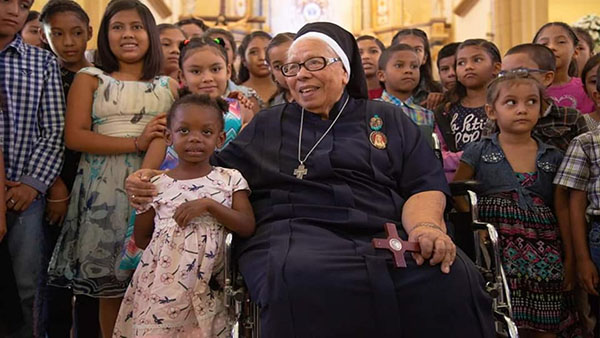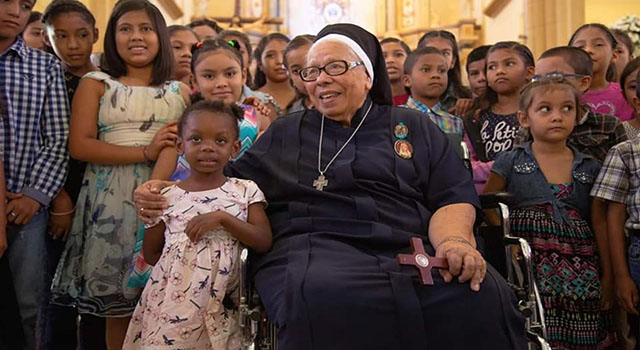By Jose Antonio Varela Vidal -
She holds doctorates, but she taught lessons with her life. She received medals, although she preferred the people's awards. She received support and recognition, but used nothing for her own benefit. Her name was Sister María Rosa Leggol and she is remembered by nearly 80,000 beneficiaries of her works as the "Mother Teresa of Central America."
With this title, worth more than the academic degrees or tributes received, this 93-year old Franciscan nun said goodbye to her native Honduras on Oct. 16, 2020, submissive to the call of the only one who, she said, could give her orders: God himself.
This strong-willed nun used to say in public and in private that "there was no man on earth who could force her to do anything." Rather than contempt for the authority of the Church, whose pastors always supported and encouraged her during her lifetime, the phrase denotes a profound spirituality: We only obey God.
Subdued by what defeated her in her last battle, COVID-19, her death has allowed the far-reaching work of Mother María Rosa to be recognized in its proper measure.
She received the first of the posthumous medals during her wake, from the hands of Cardinal Oscar Rodríguez Maradiaga, her archbishop in Tegucigalpa. There, the prelate announced the opening of the cause for beatification of this daughter, glory of the Church, mother of the dispossessed and witness that Latin America can transform misery into mercy.

Photographer: COURTESY
Sister Maria Rosa Leggol is remembered by nearly 80,00 beneficiaries of her works as the "Mother Teresa of Central America." She died Oct. 16, 2020, at the age of 93, of COVID-19.
The misery that Sister María Rosa experienced is the same as in the Gospels, as well as in the past and present of the American continent: poverty, neglect of the dispossessed through public policies, exploitation and lack of opportunities.
Nevertheless, the new "Mother Teresa" did not turn a blind eye, nor did she wait for others to do the job, let alone shut herself up in her convent. She did not. Like Jesus Christ, she went out, she had compassion for the people most in need and filled them with God's mercy through her works.
A FRUITFUL LIFE
In 1966 and the following years in Honduras, specifically in Choloma and Nuevo Paraíso, our religious sister, a member of the Daughters of St. Francis of Assisi, watched with concern how families wanted to leave the streets and have access to a roof over their heads. The tense political and economic situation led people to demand the fundamental right to housing.
In the thinking of Pope Francis, this T (for the Spanish "techo", roof), as well as two others such as "trabajo" (work, always dignified and stable), and "tierra" (land, owned by and for those who work it), are "sacred rights", which, despite being inalienable, are the first to be ignored or abandoned by those in politics when they start governing.
But fortunately, the Honduran communities had their very own "Mother Teresa" who, from the outset, providentially secured ample land and financial assistance to build housing for the homeless, to whom she also would provide education and access to health care. In response to reporters, a young single mother declared, "What would have become of our future without Mother?"
It is said that, as long as her health allowed it, Sister María Rosa would jump like a spring with a steady hand and step, determined to solve the problems of the people when she saw their needs. Her collaborators remember that, while planning the works of her mind and heart, her restlessness shifted to her hands and into action, along with an encouraging smile constantly present on her face. With this contented disposition of soul, she enlightened and gave hope to mothers with their children, to forgotten grandparents, to deprived young people and to the victims of natural disasters, whether they lived in Nicaragua, Guatemala or other countries in the region.
But that spring did not trigger alone; behind this consecrated woman there was a whole team of collaborators who "jumped into the pool" with her without knowing where they would go or how they would do it. But they were convinced that in the end, the nun, who was at the same time their leader and their strict boss, would lead them to inaugurate a new project of great magnitude very soon. That is why they were convinced when she explained to them why she did the work: "I helped them because God sent me to do so." All those who mourn her absence pray that he continue to send her from heaven.
TO PRESERVE HER MEMORY AND IMITATE HER
In order to make known the life of Sister María Rosa, so fruitful and full of faith in God, of authentic Christian charity and unbending will, a video documentary about her life is being produced aimed at the younger generations and those who do not yet know her.
This project, led by the Miraflores Films production company and titled "With This Light," will encourage those who are committed to the growth and continuity of the "Sociedad Amigos de los Niños" (Friends of the Children Society), founded by her.
The objective of the audiovisual project is to make her better known and also to bring her closer to popular piety so that she may be invoked with confidence, as a friend and help that is in heaven, with the conviction that she intercedes from there and responds with tangible works for the most needy, as she always did.
The causes of beatification and canonization are often held up in the dioceses or in the Vatican because the life and teachings of the venerable or servants of God are not adequately disseminated. It is necessary to show how exemplary and virtuous their lives were, their commitment to the people, their motivating writings and, above all, the guiding thread of their existence on earth, in order to be recognized as one of those saints "next door," as Pope Francis has identified them.
COME AND SEE
In these times of digital information, there is no need to go to Honduras or neighboring countries to appreciate the work of the "Mother Teresa of Central America." This can be learned in detail and visually on her foundation's website and social networks.
There you can see that, to date, hundreds of thousands of services have been provided, focusing on adolescents, children and families in a degree of vulnerability or as "unlikely," as CELAM refers to the desperately poor who seem as if they will never get out of their biggest problem: moving away from the evil line of poverty.
There are several ways to assist in the work of Sister María Rosa, either through professional or solidary volunteering, or supporting specific projects such as construction, security, recreation, vegetable crops, capacity building, educational or health services, in order to provide comprehensive quality care to each child, young person or family. And, as always, if you find that you are able to offer financial support, you can send your contribution or donations to the apostolic work founded by her in Honduras.
To learn more, visit www.sanhn.org.
Jose Antonio Varela is a Peruvian journalist who writes for La Voz Católica. This article first appeared in print in the newspaper's February 2022 edition.

